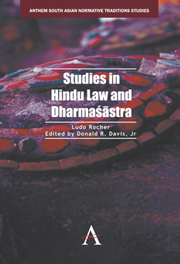Book contents
- Frontmatter
- Contents
- Foreword by Richard W. Lariviere
- Preface
- Abbreviations
- Note on the Edition
- Introduction
- PART ONE THE NATURE OF HINDU LAW
- PART TWO GENERAL TOPICS OF HINDU LAW
- PART THREE HINDU LEGAL PROCEDURE
- The Theory of Proof in Ancient Hindu Law
- The Problem of the Mixed Reply in Ancient Hindu Law
- The Reply in Hindu Legal Procedure: Mitra Miśra's Criticism of the Vyavahāra-Cintāmaṇi
- “Lawyers” in Classical Hindu Law
- Anumāna in the Bṛhaspatismṛti
- PART FOUR TECHNICAL STUDIES OF HINDU LAW
- PART FIVE ANGLO-HINDU AND CUSTOMARY LAW
- Bibliography
- Index
Anumāna in the Bṛhaspatismṛti
from PART THREE - HINDU LEGAL PROCEDURE
Published online by Cambridge University Press: 05 February 2013
- Frontmatter
- Contents
- Foreword by Richard W. Lariviere
- Preface
- Abbreviations
- Note on the Edition
- Introduction
- PART ONE THE NATURE OF HINDU LAW
- PART TWO GENERAL TOPICS OF HINDU LAW
- PART THREE HINDU LEGAL PROCEDURE
- The Theory of Proof in Ancient Hindu Law
- The Problem of the Mixed Reply in Ancient Hindu Law
- The Reply in Hindu Legal Procedure: Mitra Miśra's Criticism of the Vyavahāra-Cintāmaṇi
- “Lawyers” in Classical Hindu Law
- Anumāna in the Bṛhaspatismṛti
- PART FOUR TECHNICAL STUDIES OF HINDU LAW
- PART FIVE ANGLO-HINDU AND CUSTOMARY LAW
- Bibliography
- Index
Summary
There are instances in the Dharmaśāstras in which the term anumāna has the classical, technical meaning: “inference.” For instance, in the KS:
ākāreṅgitaceṣṭābhis tasya bhāvaṃ vibhāvayet,
prativādī bhaved dhīnaḥ so ‘numānena lakṣyate.
kampaḥ svedo ‘tha vaikalyam oṣṭhaśoṣābhimarśane,
bhūlekhanaṃ sthānahānis tiryagūrdhvanirīkṣaṇam,
svarabhedaś ca duṣṭasya cihnāny āhur manīṣiṇaḥ. (385–86)
Kane translates the first stanza as follows: “(The judge) should discern the (real) intention (or mental state) from the outward manifestations (such as sweat, horripilation), the gestures (looking down at the ground, etc.) and physical movements; the litigant becomes a losing party and he is found out (to be so) by inference (from the signs mentioned above).” The possibility for the judge to derive conclusions from certain indications in the behavior of the parties to a lawsuit was known long before Kātyāyana: examples of duṣṭalakṣaṇāni are found in Manu, Yājñavalkya (2.13–15), Nārada (1.193–96), Viṣṇu (8.18), and others. The relevant passage from Manu is as follows:
bāhyair vibhāvayel liṅgair bhāvam antargataṃ nṛṇām,
svaravarṇeṅgitākāraiś cakṣuṣā ceṣṭitena ca;
ākārair iṅgitair gatyā ceṣṭayā bhāṣitena ca,
netravaktravikāraiś ca gṛhyate ‘ntargataṃ manaḥ. (8.25–26)
This is Bühler's translation of the first stanza: “By external signs let him discover the internal disposition of men, by their voice, their colour, their motions, their aspect, their eyes, and their gestures.” Manu merely mentions the term liṅga. It is clear, however, that the text envisages a process in which the observation of a liṅga leads to the establishment of a sādhya, to which the liṅga is related by vyāpti.
- Type
- Chapter
- Information
- Studies in Hindu Law and Dharmasastra , pp. 435 - 442Publisher: Anthem PressPrint publication year: 2012



